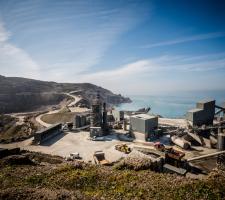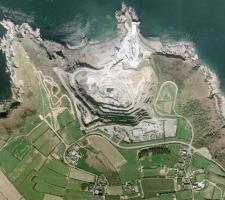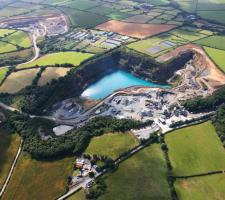
Founded in 2016 by a trio of former
Launched just three years ago by Max Vermorken (CEO), David Barrett (chairman), and Charles Trigg (technical director), SigmaRoc has wasted no time in establishing an eye-catching building materials sector portfolio of five small to medium-sized enterprises in England, Wales and the Channel Islands. The acquisitions and development of its companies helped SigmaRoc achieve a pre-tax profit of £5.5mn in 2018 – 113.8% up on 2017 - and annual revenues of £41.2mn (€45.34mn) – up 52% on £27.1mn (€29.83mn) in 2017.
The group’s first-half 2019 trading was also healthy, with revenues of £29.8mn and pre-tax profit of £3.5mn - up 49.7% and 25% respectively on H1 2018.
The next step, Vermorken tells Aggregates Business, is to generate significantly more revenues and continue to increase pre-tax profits through further savvy acquisitions backed up by informed local market knowledge-led management.
“David Barrett was an entrepreneur who set up a business that was eventually sold to LafargeHolcim. David, Charles and I were all working for
“We wanted to do something in a decentralised way, and the achievement of SigmaRoc to date is that we’ve been successful in doing that. We run a business model on platforms; platforms consisting of connected companies in a certain region. The effective distance between the end customer and the CEO of the whole group is one person – the managing director running the regional platform. The MD constantly speaks to their customers and I constantly speak to that MD, so I’m very close to the market realities. In all industry where products do not travel far, this is a key competitive advantage.”
SigmaRoc’s three current operating platforms are Ronez in the Channel Islands; Sigma PPG (Precast Products Group) in England; and Sigma SW in Wales. A fourth, in Northern Europe, is in the process of being created after SigmaRoc conditionally agreed in September 2019 to purchase Stone, the Belgian sea defence rock quarrying group.
The Ronez operations supply the Channel Islands with aggregates, ready-mixed concrete, asphalt and precast concrete products. Operating out of St John’s Quarry in Jersey and Les Vardes Quarry in Guernsey, Ronez offers a full range of high-quality construction materials. The firm also undertakes contracting services.
The creation of shipping division SigmaGsy by SigmaRoc has helped with transporting dry-bulk materials to Ronez sites, resulting in higher profits and operational efficiency.
The second platform, Sigma PPG (Precast Products Group), is a cluster of three companies specialising in manufacturing precast concrete products. With locations in North-West, East & Central England as well as London, the companies supply a wide and diverse range of industries, ranging from housebuilders and farmers to sea defences and car parks contractors. Sigma PPG firms are some of the most experienced and innovative in the industry: some operating for over 70 years, while others hold a record number of patents and licences.
Allen Concrete manufactures precast concrete products for the fencing and building industries. Plants in Surrey and Northamptonshire utilise modern production methods and machinery backed by careful quality control for the mass production of a large range of standard products.
The company’s expertise in the field of precast concrete production is based on more than 60 years’ experience and is available to support the manufacture of all types of special units.
The second company in the platform is Poundfield Products, a precast and prestressed concrete manufacturer based in Suffolk. Founded in 1999 to supply the concrete needs of the farming and industrial community in East Anglia, it developed the UK’s now leading free-standing retaining wall system, the Alfabloc. It was immediately successful and today is manufactured not just in Suffolk, but also under licence in Ireland and mainland Europe.
In January this year, Poundfield Products partnered with American giant Lindsay Corporation to bring to the UK the Road Zipper, a smart-lane separation system made of concrete and with the ability to change lanes in real time.
Another company within Sigma PPG, CCP Building Products is a supplier of concrete products and aggregates in North-West England and North Wales. Its reputation for supplying high-quality, competitively priced product is well known throughout the industry and has been built on the foundations of 60 years of service to the industry.
Its portfolio of annual production includes 1.8 million precast aggregate blocks of one specification or another and over 600,000 paving flags, not including any other bespoke product that is currently manufactured.
Acquired in April this year, GD Harries (GDH) is the cornerstone of the Sigma SW platform. It is one of Wales’s largest independent suppliers of aggregates. Headquartered in West Wales, it operates out of eight granite and limestone quarries – incorporating three asphalt plants. six concrete plants, and a wharf operation, as well as a civil engineering division delivering significant infrastructure projects.
Emphasising the importance of GDH to SigmaRoc, Vermorken, a Dutch national, says: “GDH is a very significant business which offers 80 million tonnes of aggregate reserves. It has a great management team locally. Co-founder Ian Harries is still there with his partner, Janet. It’s a fully-integrated company that is the leader in their local market.
“We are building around strong companies in each of our platforms. We are starting a fourth platform in Northern Europe, again around a main business [Stone] which allows us to integrate other assets around it. We set our operating region as within two hours’ flight of London. It means you can get there and see what’s happening on the ground and then back on the evening of the same day. It gets you to Scandinavia and to northern France, Germany and the Benelux countries. All of those countries’ markets are of a key interest to us, some more for aggregates and others more for precast concrete and other building materials, depending on the structure of the local market.”
Vermorken says SigmaRoc has brought in experienced aggregates entrepreneur Emmanuel Maes as managing director of its European arm to assist with the development of a Northern Europe platform. “Emmanuel built Group de Cloedt over 10 years from what was a family marine aggregates dredging business into a €240 million annual turnover business that is one of the largest of its kind in Northern Europe. When he left last year, the firm was operating across Scandinavia, the Baltic countries, Germany, France and Holland. He brings a lot of in-depth knowledge of those markets and will help us to target the right businesses.” In conjunction with the recent conditional agreement to acquire Stone, which operates two quarries, a wharf and a contracting business in Belgium, focusing on armour rock for river and sea defence work, Jacques Emsens has agreed to join the board of SigmaRoc as a non-executive director.
Emsens has previously helped build SCR-Sibelco into a leading materials solutions and specialty sands company. Founded by the Emsens family, Sibelco achieved revenue of €3.5bn in 2018, with operations in 30 countries and employing over 10,000 people. Emsens serves on the board of Sibelco and on the board of Sofina (Société Financière de Transports et d’Entreprises Industrielles), one of Belgium’s largest investment companies.
He is expected to join the board in the coming months, following the completion of the acquisition of Stone and customary director due diligence.
Further adding to SigmaRoc’s in-house executive expertise is
“Tim brings decades of technical and markets’ expertise, including 10 years helping to build Breedon up from zero to a £1 billion a year revenue business,” says Vermorken. “He’s got a good business network right across England and Wales. He’s been operating in those countries for more than 40 years, so he knows everyone.
“We are going through a similar story with a different operating model. He will help steer and guide us, helping us to avoid any mistakes and go faster growthwise than we are now.”
I ask Vermorken, who holds a PhD in Financial Economics from University College London, who he considers SigmaRoc’s rivals to be and how his company stands out from them. “There is a company in the U.S. called
“In terms of rivalling us for the companies we are looking to purchase, I would say Breedon in the UK and Ireland. The group hasn’t, as yet, established itself in continental Europe. Because of the language and cultural barriers and the types of localised markets, it is less easy to build a large-scale aggregator of construction materials businesses than in the UK or U.S. Group de Cloedt was also very active in this space over the past ten years under Emmanuel Maes’ leadership.
“The businesses we are after, typically, are too small for a private equity firm to go after; largely due to their cost structure, or a lack of certain expertise. The businesses are also usually too large for family businesses to buy, as they can’t generate enough funding for an acquisition. This creates a gap for transactions worth around £10-£100 million.”
Vermorken says SigmaRoc’s acquisition strategy focuses primarily on acquiring aggregates quarrying companies. “Quarries allow you to generate cash through a business cycle even if you are not very profitable, as you are monetising your assets. Quarries are also in short supply. No one wants to live next to one, so it’s difficult to open a new one.
“There are other businesses that we like for their uniqueness. If you take Poundfield Products, for example, when Heathrow Terminal 3 was being rebuilt, all the security barriers around the airport were Poundfield precast products. That is because of the unique structure of type of their retaining wall system, which has around 20 patents and trademarks with it.
“We buy something that’s already good and clean it up. When I say ‘clean it up’ I mean make it run more efficiently. In some cases, owners simply lacked exposure to management practices developed by larger groups, leaving us the opportunity to improve on their track record. We then start to look at what more we can do with the business that we’ve got. That includes looking at new markets and investing in research and development.”
Making critical business decisions and high-level business strategising has long been a feature of Vermorken’s career. Prior to his senior executive role at LafargeHolcim, he worked in private equity at the Luxembourg-headquartered Genii Group, where he reported directly to its founding senior executives. He is keen to emphasise how the SigmaRoc business model places a firm emphasis on localised customer support. “All the major building material players have a central call centre. When someone in South Wales wants a load of concrete, they might have to call, say, someone in Leicester. I’ll bet the Leicester call taker doesn’t know who the caller is and what issues they might be facing, for example traffic or weather issues locally. If you want good customer service, you need to have a call taker in South Wales who knows exactly where the product is coming from, where it’s going and who you are. From an overheads’ perspective, it’s probably slightly more expensive to have localised call takers, but it enables us to have more customers at a better margin locally, because people who buy from us understand they will get the service they need.
“We said at the beginning that we could run SigmaRoc as a six- or seven-platform business, that we could run each platform at £10-£12 million EBITDA [earnings before interest, tax, depreciation & amortisation]. That gets you close enough to £100 million EBITDA. We were around £10 million EBITDA last year. It’s fun. We’re, in some ways, changing the way the industry operates, moving away from vertical integration. The opportunity is there, so why not take it?”
With big plans to establish itself in the Northern European building materials market, added to the ongoing development of its three current commercial platforms, it promises to be a very busy next 12-18 months for SigmaRoc. Given their ambitious business model, Vermorken and his management team wouldn’t want it any other way.












